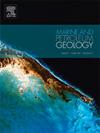挪威大陆架烃源岩中的汞与成熟度、沉积环境和年龄有关
IF 3.6
2区 地球科学
Q1 GEOSCIENCES, MULTIDISCIPLINARY
引用次数: 0
摘要
石油中汞(Hg)的来源在文献中有争议,可能源于;富含汞的黑色页岩生产石油和煤炭,靠近深断层,作为深汞源的迁移路线,靠近大型火成岩省。为了阐明挪威大陆架石油中汞的来源,对来自北海、挪威和巴伦支海油井的268个主要富含有机的岩心样本进行了汞和其他重金属的分析。此外,对Embla油田泥盆系和二叠系储层砂的5个岩心样品和6个油品进行了分析。我们的研究表明,汞浓度升高的沉积物与缺氧沉积环境有关。研究还表明,汞在烃源岩中运移的温度区间与生油温度区间相同,烃源岩中汞的浓度随着排油而降低。认为油中的汞可能携带了油源信息;烃源岩类型和年龄。本文章由计算机程序翻译,如有差异,请以英文原文为准。
Mercury in source rocks on the Norwegian Continental Shelf; link to maturity, depositional environment and age
The source of mercury (Hg) in petroleum is debated in the literature and could stem from; Hg rich black shales producing petroleum, coals, proximity to deep faults acting as migration routes from deep Hg sources, and proximity to large igneous provinces. In an attempt to cast light on the source of Hg in oils on the Norwegian Shelf 268 mainly organic rich core samples from wells in the North Sea, Norwegian and Barents Sea were analysed for Hg and other heavy metals. In addition 5 core samples from Devonian and Permian reservoir sands and 6 oils from the Embla field were analysed. Our study shows that sediments with elevated Hg concentrations are associated with anoxic depositional environments. The study also show that Hg is mobilized in the source rock at the same temperature interval that generates oil and that the concentration of Hg in the source rock decreases with expulsion of oil. It is suggested that Hg in oil may carry information about the origin of the oil; source rock type and age.
求助全文
通过发布文献求助,成功后即可免费获取论文全文。
去求助
来源期刊

Marine and Petroleum Geology
地学-地球科学综合
CiteScore
8.80
自引率
14.30%
发文量
475
审稿时长
63 days
期刊介绍:
Marine and Petroleum Geology is the pre-eminent international forum for the exchange of multidisciplinary concepts, interpretations and techniques for all concerned with marine and petroleum geology in industry, government and academia. Rapid bimonthly publication allows early communications of papers or short communications to the geoscience community.
Marine and Petroleum Geology is essential reading for geologists, geophysicists and explorationists in industry, government and academia working in the following areas: marine geology; basin analysis and evaluation; organic geochemistry; reserve/resource estimation; seismic stratigraphy; thermal models of basic evolution; sedimentary geology; continental margins; geophysical interpretation; structural geology/tectonics; formation evaluation techniques; well logging.
 求助内容:
求助内容: 应助结果提醒方式:
应助结果提醒方式:


